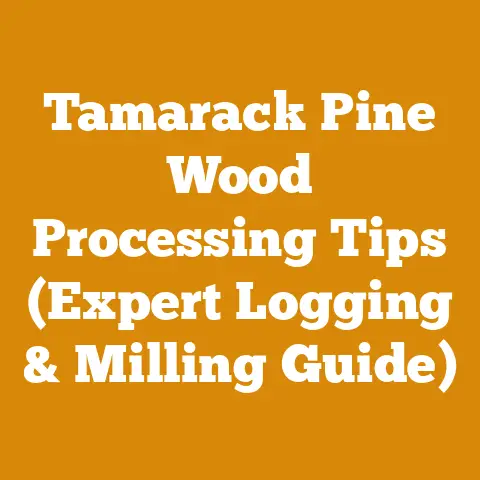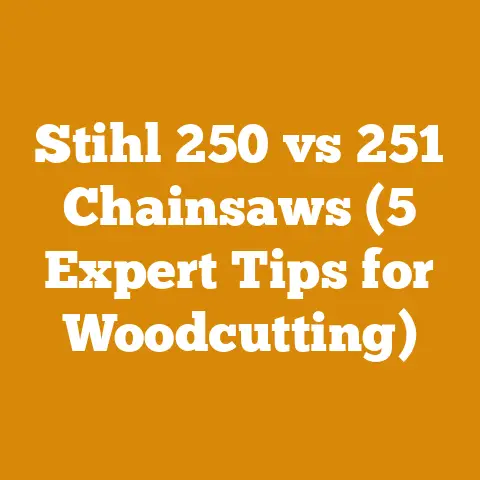Professional Tree Pruning Before and After (5 Expert Techniques)
Tired of looking at trees that resemble overgrown shrubs more than majestic specimens?
Do you yearn for a landscape that’s not only beautiful but also healthy and thriving?
Then let’s talk about professional tree pruning.
It’s more than just lopping off branches; it’s an art and a science that can dramatically transform your outdoor space.
I’ve spent years felling trees, processing timber, and yes, carefully pruning trees, and I’ve seen firsthand the incredible difference expert pruning can make.
It’s an investment that pays dividends in the long run, both aesthetically and for the health of your trees.
The State of the Trees (and the Pruning Industry)
Globally, the tree care industry, including pruning, is booming.
Market research suggests a steady growth trajectory, driven by increasing urbanization and a greater awareness of the environmental and aesthetic benefits of trees.
In North America alone, the tree care industry is estimated to be worth billions of dollars annually.
This growth isn’t just about removing hazardous trees; it’s increasingly about proactive tree health management, which includes expert pruning.
While precise global figures are hard to pin down, the trend is clear: professional tree care is on the rise.
One challenge?
Finding qualified arborists.
The industry faces a skilled labor shortage, making it crucial to understand what distinguishes a true professional from someone who just owns a chainsaw.
That’s where this guide comes in.
I’m going to share five expert tree pruning techniques that will help you understand the “before and after” transformation and empower you to either tackle some pruning yourself (safely!) or better assess the work of a hired arborist.
Professional Tree Pruning: Before and After (5 Expert Techniques)
Let’s dive into the heart of the matter: how to prune trees like a pro.
These aren’t just random cuts; they’re strategic interventions designed to improve the health, structure, and appearance of your trees.
1. Crown Thinning: Letting the Light Shine In
Crown thinning is exactly what it sounds like: reducing the density of the tree’s crown.
This technique focuses on removing selected branches to increase light penetration and air circulation throughout the tree.
Think of it as giving your tree a chance to breathe.
Why it Matters: Denser canopies can trap moisture, leading to fungal diseases.
Improved air circulation helps dry out leaves and branches, reducing the risk of infection.
Increased light penetration also encourages growth on inner branches, creating a fuller, more balanced tree.The Technique:
- Assessment: Before you even think about cutting, stand back and assess the tree.
Look for dense areas, crossing branches, and branches that are growing inward.
These are prime candidates for removal. - Branch Selection: Focus on removing:
- Dead, diseased, or damaged branches: These are always the first to go.
- Rubbing or crossing branches: These can create wounds and entry points for disease.
- Water sprouts and suckers: These are vigorous, upright shoots that often grow from the trunk or branches.
They steal energy from the tree and disrupt its form. - Weakly attached branches: Look for narrow crotch angles (where the branch joins the trunk).
These are prone to breakage.
- The Three-Cut Method: This is crucial for preventing bark tearing.
- Cut 1: Make an undercut a few inches from the branch collar (the swollen area where the branch joins the trunk).
Cut about one-third of the way through the branch. - Cut 2: Make a top cut a few inches further out from the undercut.
The branch will break away, preventing it from tearing the bark. - Cut 3: Make the final cut just outside the branch collar, at a slight angle.
This allows the wound to heal properly.
- Cut 1: Make an undercut a few inches from the branch collar (the swollen area where the branch joins the trunk).
- Spacing: Aim for even spacing between the remaining branches.
This ensures good light penetration and air circulation.
Don’t remove more than 25% of the crown in a single pruning session.
- Assessment: Before you even think about cutting, stand back and assess the tree.
Tool Selection: A good pair of pruning shears, loppers, and a pruning saw are essential.
For larger branches, a chainsaw might be necessary, but always prioritize safety and proper training.
I personally prefer using a Silky Zubat pruning saw for branches up to 6 inches in diameter.
It’s incredibly sharp and efficient.Before and After: The “before” tree will often appear dense and congested, with a lot of interior deadwood.
The “after” tree will have a more open canopy, with sunlight reaching the inner branches.
The overall shape will be more balanced and aesthetically pleasing.Case Study: I once thinned the crown of a mature maple tree in a client’s yard.
Before pruning, the grass beneath the tree was struggling due to lack of sunlight, and the tree had several dead branches.
After thinning, the grass thrived, and the tree looked healthier and more vibrant.
The client was amazed at the transformation.
2. Crown Raising: Lifting the Skirt
Crown raising involves removing lower branches to increase clearance beneath the tree.
This is often done to improve visibility, allow for pedestrian or vehicle traffic, or simply to create a more open landscape.
Why it Matters: Low-hanging branches can obstruct walkways, driveways, and views.
They can also create safety hazards, especially if they’re damaged or weak.
Crown raising improves accessibility and aesthetics.The Technique:
- Determine the Desired Clearance: Consider the purpose of the space beneath the tree.
If it’s a walkway, you’ll need at least 7 feet of clearance.
For vehicles, you’ll need more. - Branch Selection: Choose branches that are growing downward or are interfering with the desired clearance.
Avoid removing too many branches at once, as this can stress the tree. - The Three-Cut Method: Use the same three-cut method described above to prevent bark tearing.
- Maintain a Natural Shape: Avoid creating a “lollipop” effect by removing too many lower branches.
The goal is to raise the crown while maintaining a natural, balanced shape.
- Determine the Desired Clearance: Consider the purpose of the space beneath the tree.
Tool Selection: Loppers and a pruning saw are typically sufficient for crown raising.
For larger branches, a chainsaw might be necessary.Before and After: The “before” tree will have low-hanging branches that obstruct the view or interfere with traffic.
The “after” tree will have a clear trunk and an open space beneath the crown.Example: I recently crown-raised several oak trees along a driveway.
Before pruning, the branches were scraping against vehicles.
After pruning, the driveway was clear, and the trees looked much more elegant.
3. Crown Reduction: Size Matters (Sometimes Less is More)
Crown reduction involves reducing the overall size of the tree by shortening branches.
This technique is often used to control the height or spread of a tree, or to improve its shape.
It’s a more drastic measure than crown thinning or raising and should be done with care.
Why it Matters: Crown reduction can be necessary when a tree is growing too close to buildings, power lines, or other structures.
It can also be used to improve the tree’s shape or to correct structural problems.The Technique:
- Identify the Target Size: Determine how much you want to reduce the tree’s size.
Avoid removing more than 25% of the crown in a single pruning session. - Cut Back to a Lateral Branch: This is crucial for maintaining the tree’s natural growth habit.
Never cut back to a stub; always cut back to a healthy lateral branch that is at least one-third the diameter of the branch you’re removing. - Maintain a Natural Shape: Avoid creating a flat or unnatural appearance.
The goal is to reduce the size of the tree while maintaining its natural form. - The Three-Cut Method: Use the same three-cut method described above to prevent bark tearing.
- Identify the Target Size: Determine how much you want to reduce the tree’s size.
-
Tool Selection: Loppers, a pruning saw, and a chainsaw are often necessary for crown reduction.
Before and After: The “before” tree will be too large or overgrown for its location.
The “after” tree will be smaller and more manageable, with a more balanced shape.Caution: Crown reduction can stress a tree if it’s done improperly.
It’s important to consult with a certified arborist before attempting this technique.
4. Restoration Pruning: Giving Trees a Second Chance
Restoration pruning is used to improve the structure and health of neglected or damaged trees.
This technique often involves removing a significant amount of deadwood, broken branches, and poorly formed limbs.
It’s like giving a tree a second chance at life.
Why it Matters: Neglected trees can become structurally unsound and prone to breakage.
Restoration pruning can help to restore their health and stability.The Technique:
- Remove Dead, Diseased, and Damaged Branches: This is the first and most important step.
Remove all deadwood, broken branches, and branches that show signs of disease. - Correct Structural Problems: Identify any structural weaknesses, such as narrow crotch angles or co-dominant leaders (two main stems competing for dominance).
Correct these problems by removing one of the competing stems or by cabling and bracing weak branches. - Thin the Crown: Thin the crown to improve light penetration and air circulation.
- Gradual Approach: Restoration pruning should be done gradually, over a period of several years.
Avoid removing too much at once, as this can stress the tree.
- Remove Dead, Diseased, and Damaged Branches: This is the first and most important step.
-
Tool Selection: Loppers, a pruning saw, and a chainsaw are typically necessary for restoration pruning.
Before and After: The “before” tree will be overgrown, with a lot of deadwood and structural problems.
The “after” tree will be healthier, more stable, and more aesthetically pleasing.My Experience: I once restored a neglected apple tree that had been completely overgrown with deadwood and water sprouts.
After several years of careful pruning, the tree was thriving and producing a bountiful crop of apples.
It was incredibly rewarding to see the tree come back to life.
5. Espalier: The Art of Training Trees
Espalier is a technique of training trees to grow in a flat plane, typically against a wall or fence.
This technique is often used for fruit trees, but it can also be used for ornamental trees.
It’s a beautiful and space-saving way to grow trees.
Why it Matters: Espalier allows you to grow fruit trees in small spaces, such as urban gardens or patios.
It also creates a unique and aesthetically pleasing landscape feature.The Technique:
- Choose the Right Tree: Select a tree that is well-suited for espalier.
Dwarf or semi-dwarf fruit trees are often the best choice. - Install a Support System: Install a trellis, fence, or other support system to train the tree against.
- Prune and Train the Branches: Prune the tree to encourage the growth of lateral branches.
Tie the branches to the support system to train them into the desired shape. - Regular Maintenance: Espalier requires regular pruning and training to maintain its shape.
- Choose the Right Tree: Select a tree that is well-suited for espalier.
-
Tool Selection: Pruning shears and plant ties are the essential tools for espalier.
Before and After: The “before” tree will be a typical tree growing in a natural shape.
The “after” tree will be trained into a flat plane against a wall or fence, creating a unique and beautiful landscape feature.Creative Espalier: I’ve seen espalier used to create stunning living walls and edible landscapes.
It’s a truly artistic way to grow trees.
Key Concepts: Understanding the Language of Pruning
Before you grab your pruning shears, let’s clarify some key concepts.
Understanding these terms will help you make informed decisions about how to prune your trees.
- Branch Collar: The swollen area where a branch joins the trunk.
It contains specialized cells that help the wound heal properly.
Always prune just outside the branch collar, at a slight angle. - Lateral Branch: A branch that grows from the side of another branch or the trunk.
When reducing the size of a branch, always cut back to a healthy lateral branch. - Water Sprout: A vigorous, upright shoot that grows from the trunk or branches.
Water sprouts steal energy from the tree and disrupt its form.
They should be removed. - Sucker: A shoot that grows from the roots of the tree.
Suckers also steal energy from the tree and should be removed. - Crotch Angle: The angle at which a branch joins the trunk.
Narrow crotch angles are prone to breakage.
Wide crotch angles are stronger. - Co-dominant Leaders: Two main stems competing for dominance.
This can create a structural weakness.
One of the competing stems should be removed. - Deadwood: Dead branches.
Deadwood should always be removed to improve the health and appearance of the tree.
Tool Selection: Choosing the Right Weapon
Having the right tools is essential for safe and effective tree pruning.
Here’s a breakdown of the most common pruning tools:
- Pruning Shears: For small branches (up to about 3/4 inch in diameter).
- Loppers: For larger branches (up to about 2 inches in diameter).
Loppers provide more leverage than pruning shears. - Pruning Saw: For branches that are too large for loppers.
Choose a saw with a sharp blade and a comfortable handle.
As I mentioned before, I swear by the Silky Zubat. - Chainsaw: For large branches and tree removal.
Chainsaws should only be used by trained professionals. - Pole Saw: For reaching high branches without a ladder.
- Safety Gear: Always wear safety glasses, gloves, and a hard hat when pruning trees.
Timing is Everything: When to Prune
The best time to prune trees depends on the species and the type of pruning you’re doing.
However, there are some general guidelines:
- Dormant Season (Late Winter/Early Spring): This is the best time for most pruning tasks, including crown thinning, crown raising, and crown reduction.
The tree is dormant, so it will be less stressed by the pruning. - Summer: Summer pruning can be done to remove water sprouts, suckers, and deadwood.
Avoid heavy pruning in the summer, as this can stress the tree. - Flowering Trees: Prune flowering trees after they bloom.
This will allow them to set flower buds for the following year.
Cost Considerations: Budgeting for Pruning
The cost of professional tree pruning can vary depending on the size and complexity of the job.
Here are some factors that can affect the cost:
- Size of the Tree: Larger trees require more time and effort to prune.
- Complexity of the Pruning: More complex pruning tasks, such as crown reduction or restoration pruning, will cost more.
- Location of the Tree: Trees that are difficult to access will cost more to prune.
- Experience of the Arborist: Experienced arborists typically charge more than less experienced ones.
Budgeting Tips:
- Get Multiple Quotes: Get quotes from several different arborists before making a decision.
- Ask for a Detailed Estimate: Make sure the estimate includes a breakdown of the work to be done and the cost of each task.
- Consider the Long-Term Benefits: Remember that professional tree pruning is an investment that can pay dividends in the long run.
Troubleshooting: Common Pruning Pitfalls
Even with the best intentions, mistakes can happen.
Here are some common pruning pitfalls to avoid:
- Over-Pruning: Removing too much of the tree’s crown can stress the tree and make it more susceptible to disease.
- Topping: Cutting off the top of the tree.
This is a destructive practice that can lead to structural problems and a shortened lifespan. - Leaving Stubs: Leaving stubs when pruning branches. Stubs can attract pests and diseases.
- Using Dull Tools: Using dull tools can make pruning more difficult and can damage the tree.
- Pruning at the Wrong Time: Pruning at the wrong time of year can stress the tree.
Next Steps: Resources for Further Learning
Want to learn more about tree pruning?
Here are some resources to get you started:
- International Society of Arboriculture (ISA): The ISA is a professional organization for arborists.
They offer certification programs and educational resources. - Your Local Extension Office: Your local extension office can provide information on tree care and pruning in your area.
- Books and Websites: There are many excellent books and websites on tree pruning.
Conclusion: A Healthier, More Beautiful Landscape
Professional tree pruning is an investment in the health, beauty, and longevity of your trees.
By understanding the techniques and principles outlined in this guide, you can either tackle some pruning yourself (safely!) or better assess the work of a hired arborist.
Remember, a well-pruned tree is a happy tree, and a happy tree makes for a happier landscape.
So, grab your pruning shears, put on your safety glasses, and get ready to transform your outdoor space!






